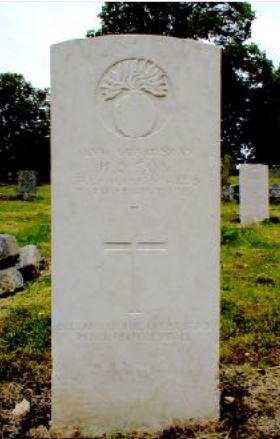2nd Battalion, Grenadier Guards

Herbert Stafford Cox was born in Minchinhampton to Joseph and Ellen (Latham) Cox in October 1887. At the 1911 Census, Joseph stated they had been married for 34 years and had nine children of whom seven were still living. Herbert was one of only two sons. Joseph’s occupation was carpenter.
At the 1901 Census, the family were living at West End, Minchinhampton. Thirteen-year-old Herbert was an errand boy. There is a Confirmation document on Ancestry dated 16 March 1901.
Herbert does not appear on the 1911 Census. His parents were still in Minchinhampton with two of his sisters and two other sisters were in domestic service elsewhere in Minchinhampton.
On researching Ancestry, there are full service records. Herbert attested for three years at Gloucester Barracks on 31 January 1906, joining the Grenadier Guards aged 18 years six months. He transferred to the reserve on 31 January 1909.
On February 14 1912, Herbert married Rosina Hilda Earney at Minchinhampton church. Her date of birth was 10 November 1987. Rosina’s address was given as Minchinhampton and her occupation as nurse. Herbert’s address was given as Longbridge Deverill and his occupation as Police Constable.
The couple’s daughter, Olive Betty was born on 5 October 1913 in Longbridge Deverill, Wiltshire where she was baptised. Herbert’s father Joseph Cox died that year.
By the end of 1915, Ellen Cox was living on the Bristol Road at Bath.
The Grenadier Guards (GG) mobilised in London at the outbreak of war on 5 August 1914. Herbert was in France with the British Expeditionary Force (BEF) from 19 October 1914 to 9 June 1915. After five months back in the UK, Herbert returned as part of the BEF on 6 November 1915 where his tour of duty did not end until 10 March 1918. Herbert joined the 1st and 7th Entrenching Battalions on November 12 and 22 respectively in 1915, re-joining the 2nd Battalion GG at the end of the month.
Herbert was injured on 15 September 1916 — gunshot wound to his right arm. The War Diary states that the 2nd GG were at the Battle of Ginchy during the Somme offensive. On the 15th, the battalion lost three officers with 232 NCSOs and men wounded of whom it can be assumed Herbert Cox was one. He was treated at 39th General Hospital Havre on 22 September and was at the Guards Base Depot at Harfleur on 1 November. He re-joined the battalion on 7 December 1916. A short period of leave was had in the UK from 29 July to 8 August 1917.
Herbert was gassed at Arras in late February/early March 1918. The actual date is inconsistent in his records. He was admitted to hospital at Abbeville where he was treated for two weeks returning to the 5th Reserve Battalion on 11th March 1918. His general condition was said to be poor with heart palpitations and lungs affected so he was discharged, Class 2.
The medical report dated 19 July 1918 taken at Chelsea Barracks summarises Herbert’s situation. Following his treatment in Abbeville, Herbert spent 30 days in hospital at Abergavenny then two months in hospital at Shoreham where he was placed in Category E. He had not served since being gassed. The report stated he was nervous of being gassed. It was established whilst he was at Shoreham, that he was suffering from VDH (valvular disease of the heart). He suffered with any exertion and could not march.
Herbert was discharged on 26 July 1918 with a recommendation that he attend a heart specialist.
He died a month later on 29 August 1918, aged 31, at home in Longbridge Deverill. The Pension Ledger states the cause of death as endocarditis, cerebral embolism and hemiplegia attributable to active service. Rosina was living at 23 Crockerton near Warminster. The CWGC states that she was a nurse at the Infirmary, Andover Hampshire.
Herbert was buried at Minchinhampton (Holy Trinity) Churchyard on 2 September 1918 with a CWGC headstone. The venue is perhaps surprising as neither his wife or Mother lived in the area. He is remembered on the war memorial at Minchinhampton, inside Holy Trinity Church and St Peter and St Paul’s Church, Longbridge Deverill.
Herbert’s younger brother, Arthur, also served during the war and was a recipient of the Military Medal (MM), authorised on 24 January 1919. Single and a carpenter, he had emigrated to Ontario, Canada in 1907 and enlisted in London, Ontario with the Canadian Expeditionary Force on 20 December 1915. His service records are available for free research on the Library and Archives Canada website. He suffered a gunshot wound to his left arm in 1917. He was killed in action at Vis-en-Artois on 28 August 1918 (the day before his brother died in England). He has no known grave and is remembered on the Vimy Memorial. The Canadians were involved in the Battle of the Scarpe from 26 August 1918. They lost 254 officers and 5,547 men during the three days of the battle. It can be assumed that Arthur was one of them.
At the 1939 England and Wales register, Ellen Cox was living in Bath with two of her daughters, Rose and Kate. She died in 1955.
I have been unable, with certainty, to follow Rosina and Olive’s history after the war.
Researched by Helen Wollington March 2021
